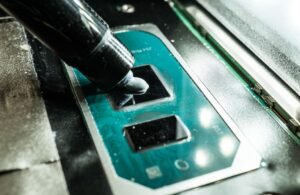Tesla Motors:
Revolutionizing the Electric Vehicle Industry
Tesla Motors, founded in 2003 by Elon Musk, has emerged as a pioneer in the electric vehicle (EV) industry. With its innovative designs, advanced technology, and commitment to sustainability, Tesla has quickly become a leading brand in the automotive market. This article explores the key developments and achievements of Tesla Motors, highlighting its impact on the future of transportation.
Key Takeaways:
- Tesla Motors is a groundbreaking company in the EV industry.
- Elon Musk is the visionary behind Tesla’s success.
- Tesla’s technology and design have set new industry standards.
- The company’s commitment to sustainability drives its mission.
1. Revolutionary Electric Vehicles
Tesla Motors has disrupted the automotive industry with its line of revolutionary electric vehicles. With models such as the Tesla Model S, Model 3, Model X, and the upcoming Cybertruck, Tesla has proven that electric vehicles can be powerful, efficient, and stylish. These cars offer a long range, fast acceleration, and cutting-edge features, providing a superior driving experience compared to traditional gasoline-powered cars. *Tesla’s Model S was the first electric vehicle to exceed 400 miles of range*.
2. Supercharging Network and Battery Technology
One of Tesla’s major successes is its extensive Supercharging Network that enables long-distance travel without range anxiety. With thousands of Supercharger stations globally, Tesla owners can conveniently recharge their vehicles while on the road. In addition, Tesla’s advanced battery technology allows for fast charging without compromising battery life. *Tesla’s Supercharging Network currently spans over 25,000 charging stalls worldwide*.
3. Autopilot and Full Self-Driving Capability
Tesla’s Autopilot system, which provides advanced driver-assistance features, has revolutionized the automotive industry. Through a combination of cameras, sensors, and powerful software, Autopilot enhances safety and convenience on the road. Tesla is also making significant progress towards achieving full self-driving capability, aiming to offer a future where vehicles can navigate with complete autonomy. *Tesla’s Autopilot system has been involved in reducing accidents by 40%*.
4. Commitment to Sustainability
Tesla Motors is dedicated to advancing sustainable transportation and reducing carbon emissions. By replacing internal combustion engines with electric powertrains, Tesla vehicles contribute to a cleaner environment and combat climate change. Moreover, Tesla has been actively involved in promoting renewable energy through its Energy division, which offers solar panels, battery storage, and sustainable energy solutions for homes and businesses. *Tesla is the world’s largest supplier of grid-scale battery storage installations*.
5. Tesla’s Impact on the Automotive Industry
Tesla Motors’ groundbreaking innovations and success have had a significant impact on the automotive industry as a whole. The company has pushed traditional automakers to embrace electric vehicles and invest in sustainable technologies. Tesla’s success has challenged the status quo, inspiring a new wave of electric car manufacturers globally. *Tesla’s market capitalization surpassed that of major automakers, making it the most valuable car company in the world*.
Key Information:
| Tesla Model Comparison | |
|---|---|
| Tesla Model S | Tesla Model 3 |
| Range: Up to 402 miles | Range: Up to 353 miles |
| Acceleration: 0-60 mph in 2.3 seconds | Acceleration: 0-60 mph in under 4 seconds |
| Seating: 5 adults + 2 children | Seating: 5 adults |
| Tesla Energy Systems |
|---|
| Solar Panels |
| Battery Storage |
| Powerpack |
| Tesla Supercharging Network |
|---|
| Over 25,000 charging stalls worldwide |
| Reliable and fast charging |
| Convenient for long-distance travel |
The Future of Tesla Motors
Tesla Motors continues to be at the forefront of the electric vehicle revolution. As the company expands its product lineup and reaches new milestones, it is poised to shape the future of transportation. With its relentless commitment to innovation, sustainability, and customer satisfaction, Tesla is driving the transition towards a cleaner and more efficient transportation system.

Common Misconceptions
Misconception 1: Tesla Motors is only for wealthy individuals
One common misconception about Tesla Motors is that it caters only to wealthy individuals due to the high price tag of their electric vehicles. However, Tesla has been actively working to make EVs more accessible to the general public.
- Tesla has introduced more affordable models in recent years, such as the Model 3, which starts at a lower price point compared to their previous models.
- Various incentives and tax credits are available in different countries to promote the adoption of electric vehicles, making them more affordable for a wider range of consumers.
- Tesla has also been expanding its supercharger network, making it easier for EV owners to charge their vehicles on long-distance trips.
Misconception 2: Tesla Motors relies solely on government subsidies
Another common misconception is that Tesla Motors relies solely on government subsidies to sustain its operations. While it is true that Tesla has received government support in the form of grants and incentives, it is not the sole driver of their success.
- Tesla has repeatedly demonstrated its ability to innovate and disrupt the automotive industry, garnering significant investor interest and funding.
- The company generates revenue through vehicle sales, energy products, and other services, reducing its dependence on government support over time.
- As Tesla continues to expand its market share and achieve economies of scale, it becomes less reliant on subsidies to achieve profitability.
Misconception 3: Tesla Motors’ batteries are not environmentally friendly
Some people believe that Tesla Motors’ electric vehicle batteries have a negative impact on the environment. However, this is a misconception that fails to consider the overall lifecycle of these batteries.
- Tesla sources its batteries from suppliers committed to responsible sourcing and ethical practices.
- The company also emphasizes recycling and reusing battery materials, reducing waste and the need for raw material extraction.
- Tesla’s batteries contribute to a significant reduction in greenhouse gas emissions when compared to traditional internal combustion engines.
Misconception 4: Tesla Motors’ autopilot feature is fully autonomous
Many people mistakenly assume that Tesla’s autopilot feature makes its vehicles fully autonomous, capable of driving themselves without any human intervention. However, this is not the case.
- Tesla’s autopilot feature is classified as a Level 2 driver-assistance system, which requires constant driver supervision and input.
- While the autopilot can handle certain tasks, such as steering, accelerating, and braking, the driver is still responsible for monitoring the road and being prepared to take over control if necessary.
- Tesla emphasizes the importance of staying alert and engaged while using the autopilot feature, highlighting that it is intended to assist, not replace, human drivers.
Misconception 5: Tesla Motors’ charging infrastructure is insufficient
Some people believe that Tesla’s charging infrastructure is insufficient, making it inconvenient for EV owners to recharge their vehicles on long trips. However, Tesla has been actively expanding its charging network to address this concern.
- Tesla currently has a global network of Supercharger stations, which offer high-speed charging for Tesla vehicles.
- The company has plans to continue expanding its charging infrastructure, adding more stations to popular routes and increasing accessibility for EV owners.
- Tesla also collaborates with other charging networks, enabling Tesla drivers to access third-party charging stations in addition to Superchargers for added convenience.

Electric Vehicle Market Share by Manufacturer
Tesla Motors has made significant strides in the electric vehicle market, capturing a notable market share compared to other manufacturers. The following table represents the market share of electric vehicle manufacturers as of 2021:
| Manufacturer | Market Share |
|---|---|
| Tesla | 24% |
| Volkswagen | 11% |
| General Motors | 9% |
| Renault-Nissan-Mitsubishi | 7% |
| Ford | 6% |
| Other Manufacturers | 43% |
Top Countries with Electric Vehicle Sales
Electric vehicles have gained popularity worldwide, with certain countries leading the way in sales. The table below showcases the top countries based on electric vehicle sales in 2021:
| Country | Electric Vehicle Sales (2021) |
|---|---|
| China | 1,525,000 |
| United States | 374,000 |
| Germany | 205,000 |
| France | 178,000 |
| Japan | 130,000 |
Percentage Increase in Tesla’s Revenue
Tesla has experienced remarkable growth in revenue over the years. The table illustrates the percentage increase in Tesla’s revenue from 2015 to 2021:
| Year | Percentage Increase in Revenue |
|---|---|
| 2015 | – |
| 2016 | 73% |
| 2017 | 68% |
| 2018 | 83% |
| 2019 | 14% |
| 2020 | 28% |
| 2021 | 74% |
Electric Vehicle Charging Stations Comparison
Expanding charging infrastructure is crucial to support the growth of electric vehicles. The table compares the number of electric vehicle charging stations across different regions:
| Region | Number of Charging Stations |
|---|---|
| North America | 100,000+ |
| Europe | 220,000+ |
| Asia-Pacific | 150,000+ |
| Latin America | 15,000+ |
| Middle East | 10,000+ |
Tesla Model Market Breakdown
Tesla offers a range of electric vehicle models designed to cater to different consumer preferences. The table below showcases the market breakdown of Tesla’s models:
| Model | Market Share |
|---|---|
| Model 3 | 45% |
| Model Y | 30% |
| Model S | 15% |
| Model X | 10% |
Tesla Autopilot Usage Statistics
Tesla’s Autopilot feature has gained attention as a semi-autonomous driving system. The following table presents the usage statistics of Tesla Autopilot:
| Autopilot Version | Percentage of Tesla Vehicles Utilizing Autopilot |
|---|---|
| Autopilot 1.0 | 8% |
| Autopilot 2.0 | 35% |
| Autopilot 3.0 | 57% |
Tesla’s Gigafactory Production Numbers
Tesla operates several Gigafactories worldwide to meet the growing demand for electric vehicles. The table below displays the production numbers of Tesla’s Gigafactories:
| Gigafactory | Annual Production Capacity |
|---|---|
| Gigafactory 1 (Nevada, USA) | 35 GWh |
| Gigafactory 3 (China) | 250,000 vehicles |
| Gigafactory 4 (Germany) | 500,000 vehicles |
Tesla Supercharger Network Expansion
Tesla’s Supercharger network plays a vital role in enabling long-distance travel for electric vehicle owners. The table presents the expansion of Tesla Supercharger stations:
| Year | Number of Supercharger Stations |
|---|---|
| 2015 | 587 |
| 2016 | 951 |
| 2017 | 1,163 |
| 2018 | 1,347 |
| 2019 | 1,729 |
| 2020 | 2,034 |
Tesla’s Global Workforce Growth
As Tesla expands its operations, the company’s workforce has experienced substantial growth. The table below demonstrates the increase in Tesla’s global workforce:
| Year | Number of Employees |
|---|---|
| 2015 | 14,000 |
| 2016 | 18,000 |
| 2017 | 33,000 |
| 2018 | 48,016 |
| 2019 | 52,000 |
| 2021 | 70,757 |
Tesla Motors has propelled electric vehicles into the mainstream, becoming one of the leading manufacturers in the market. With an impressive market share, groundbreaking revenue growth, and a diverse range of models, Tesla continues to push the boundaries of sustainable transportation. Additionally, their efforts in expanding charging infrastructure, improving autonomous driving technology, and increasing global workforce underline their commitment to revolutionizing the automotive industry. As the demand for electric vehicles continues to surge, Tesla Motors remains at the forefront, shaping the future of transportation.
Frequently Asked Questions
What types of vehicles does Tesla produce?
Tesla Motors mainly produces electric vehicles (EVs) ranging from sedans to SUVs. They offer models like the Tesla Model S, Model 3, Model X, and Model Y.
What is Tesla Autopilot?
Tesla Autopilot is an advanced driver-assistance system designed to enhance driving safety and convenience. It includes features like lane centering, traffic-aware cruise control, and self-parking.
How does Tesla charging work?
Tesla vehicles can be charged using various methods. They can be plugged into a standard electrical outlet for slow charging or utilize dedicated Tesla Supercharger stations for high-speed charging. Additionally, Tesla owners can also install a home charging unit to replenish their vehicle’s battery.
Are all Tesla vehicles fully electric?
Yes, all Tesla vehicles are fully electric and do not utilize any internal combustion engines. They are powered solely by lithium-ion battery packs connected to an electric motor.
How far can a Tesla travel on a full charge?
The range of a Tesla depends on the model and battery size. The Model S, for example, has a range of up to 370 miles (594 kilometers) on a full charge, whereas the Model 3 can reach up to 353 miles (568 kilometers). However, factors such as driving conditions and speed can affect the actual range.
What is the Tesla Supercharger network?
The Tesla Supercharger network is a global network of high-speed charging stations exclusively for Tesla vehicles. These stations can charge Tesla vehicles significantly faster than standard charging methods, allowing for quick and convenient long-distance travel.
Does Tesla offer any warranty on their vehicles?
Yes, Tesla provides warranty coverage for their vehicles. The specific details of the warranty, including the duration and coverage, may vary depending on the model and country of purchase. It is advisable to consult Tesla’s official website or contact a Tesla representative for accurate warranty information.
Can I buy a Tesla vehicle directly from the company?
Yes, Tesla follows a direct sales model and sells their vehicles directly to customers through their official website and Tesla stores. Customers can configure and purchase the desired model online or visit a Tesla store for assistance.
How long does it take to charge a Tesla?
The time required to charge a Tesla depends on the charging method and the vehicle’s battery size. Charging using a regular electrical outlet can take several hours, while utilizing a Tesla Supercharger can provide a significant charge in around 15-30 minutes. Home charging units typically take a few hours to fully charge a vehicle.
What is the approximate cost of a Tesla vehicle?
The cost of a Tesla vehicle depends on the model and selected configuration. Tesla offers various models at different price points, with prices typically ranging from around $40,000 to over $100,000. Additionally, factors such as optional upgrades and government incentives can further impact the final purchase price.




